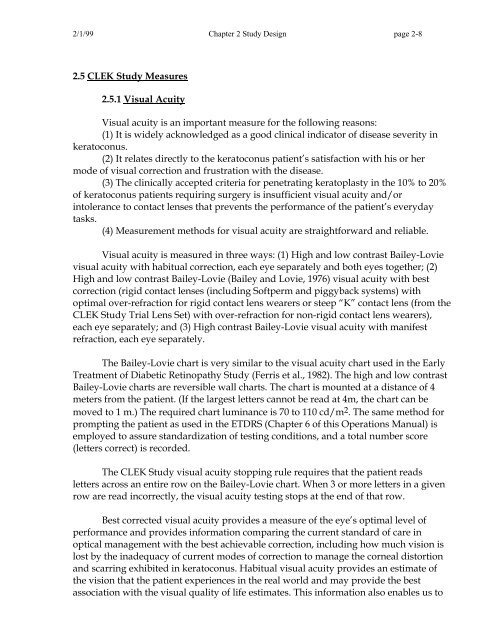OM t of c.iii - Vision Research Coordinating Center - Washington ...
OM t of c.iii - Vision Research Coordinating Center - Washington ...
OM t of c.iii - Vision Research Coordinating Center - Washington ...
Create successful ePaper yourself
Turn your PDF publications into a flip-book with our unique Google optimized e-Paper software.
2/1/99 Chapter 2 Study Design page 2-8<br />
2.5 CLEK Study Measures<br />
2.5.1 Visual Acuity<br />
Visual acuity is an important measure for the following reasons:<br />
(1) It is widely acknowledged as a good clinical indicator <strong>of</strong> disease severity in<br />
keratoconus.<br />
(2) It relates directly to the keratoconus patient’s satisfaction with his or her<br />
mode <strong>of</strong> visual correction and frustration with the disease.<br />
(3) The clinically accepted criteria for penetrating keratoplasty in the 10% to 20%<br />
<strong>of</strong> keratoconus patients requiring surgery is insufficient visual acuity and/or<br />
intolerance to contact lenses that prevents the performance <strong>of</strong> the patient’s everyday<br />
tasks.<br />
(4) Measurement methods for visual acuity are straightforward and reliable.<br />
Visual acuity is measured in three ways: (1) High and low contrast Bailey-Lovie<br />
visual acuity with habitual correction, each eye separately and both eyes together; (2)<br />
High and low contrast Bailey-Lovie (Bailey and Lovie, 1976) visual acuity with best<br />
correction (rigid contact lenses (including S<strong>of</strong>tperm and piggyback systems) with<br />
optimal over-refraction for rigid contact lens wearers or steep “K” contact lens (from the<br />
CLEK Study Trial Lens Set) with over-refraction for non-rigid contact lens wearers),<br />
each eye separately; and (3) High contrast Bailey-Lovie visual acuity with manifest<br />
refraction, each eye separately.<br />
The Bailey-Lovie chart is very similar to the visual acuity chart used in the Early<br />
Treatment <strong>of</strong> Diabetic Retinopathy Study (Ferris et al., 1982). The high and low contrast<br />
Bailey-Lovie charts are reversible wall charts. The chart is mounted at a distance <strong>of</strong> 4<br />
meters from the patient. (If the largest letters cannot be read at 4m, the chart can be<br />
moved to 1 m.) The required chart luminance is 70 to 110 cd/m 2 . The same method for<br />
prompting the patient as used in the ETDRS (Chapter 6 <strong>of</strong> this Operations Manual) is<br />
employed to assure standardization <strong>of</strong> testing conditions, and a total number score<br />
(letters correct) is recorded.<br />
The CLEK Study visual acuity stopping rule requires that the patient reads<br />
letters across an entire row on the Bailey-Lovie chart. When 3 or more letters in a given<br />
row are read incorrectly, the visual acuity testing stops at the end <strong>of</strong> that row.<br />
Best corrected visual acuity provides a measure <strong>of</strong> the eye’s optimal level <strong>of</strong><br />
performance and provides information comparing the current standard <strong>of</strong> care in<br />
optical management with the best achievable correction, including how much vision is<br />
lost by the inadequacy <strong>of</strong> current modes <strong>of</strong> correction to manage the corneal distortion<br />
and scarring exhibited in keratoconus. Habitual visual acuity provides an estimate <strong>of</strong><br />
the vision that the patient experiences in the real world and may provide the best<br />
association with the visual quality <strong>of</strong> life estimates. This information also enables us to
















